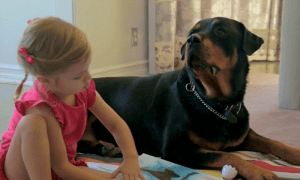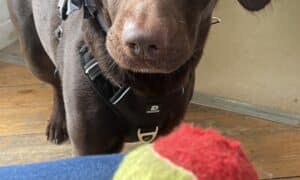“This post contains affiliate links, and I will be compensated if you make a purchase after clicking on my links.”
All living things are vulnerable to cancer, but now there is new hope when canine cancer strikes. When this happens, our natural tendency is to panic, worry, and give extra care to our canine friend. Not only that, we are also eager to find possible cures, no matter what it takes. Well, nowadays there is much more hope than in the past.
A good example is the story of the Golden Retriever named Gomez, who is 4 years old, and is owned by Gwenda Gray of Marrickville, NSW, Australia. Unlike her other dogs who lived a normal life span, Gomez suffered terminal cancer at a young age. She says that she is shocked to know that her beloved canine friend will die young. In fact, Gomez was at the prime of his life and full of energy, as many people noticed.
Unfortunately for Gomez, his cancer is an incurable, inoperable lipoma in the pelvic area. It is a tumor that continually grows and spreads throughout the nearby organs. Gomez has been given chemotherapy to hinder the growth of the tumor and is apparently improving.
Unfortunately for pet owners, cancer has no age limit or boundaries; it can come at any time of a dog’s life, to any kind of breed. Also, it has become a very common disease affecting many canine lives today.
New Hope When Canine Cancer Strikes
According to Sydney’s Animal Referral Hospital’s (ARH) veterinary oncologist, Dr. Angela Frimberger, the field of veterinary oncology has significantly improved throughout the past decade. Dr. Frimberger is the one who treats Gomez’s cancer. She also says that nowadays people are being more attentive to their pet’s health, and get the best medical care that is possible for them. And for these reasons, more dogs with cancer are living a long life, even into their senior years. The improvements have actually made cancer one of the easiest chronic canine diseases to treat.
Dr. Frimberger has estimated that more than 24,000 canine cancer cases happen each year, based on the number of cases she handles. About 15 – 20 percent of her patients have been fully cured, while the remaining 80 percent had their lives prolonged with their life quality improved significantly. There is no doubt that veterinary oncology is one of the fastest growing medical fields of today, due to their significant improvements in medical technology, equipment, methods of treatment, and medication. Diagnostic methods have also improved, allowing earlier detection. For one example, ARH recently had an MRI installed that can detect hard-to-diagnose cancers and other conditions which in the past could only be detected by surgery.
These improvements are confirmed in a Q&A article on the Pets.WebMD.com website:
Veterinary oncology has progressed amazingly in the past two decades. Twenty years ago, most people didn’t even know dogs got cancer. Today it’s common to find people whose dogs have been treated for cancer. There are so many more facilities for treating canine cancer now, and there are veterinarians who do nothing but treat cancer.
If you and your best friend are faced with this unfortunate problem in the future, just remember that there is now new hope when canine cancer strikes.
Have you had a dog who developed cancer? Please share your experiences below.






















Linda Cristiani
says:My pure-bred AKC Shih Tzu, Lucy, was the light of my life. In December 2009, at the age of 13 years, one of Lucy’s lower back teeth broke off above the gumline. This was odd, as she had great teeth, never a problem. We scheduled her to have it removed under anesthesia with a dental cleaning & exam. Before the surgery, we were at the Vet’s for pre-op bloodwork, when the Vet found a lump on the underside of her jaw, just beneath the affected tooth. Well, as you may have guessed, it was x-rayed, then removed during the surgery. It was an aggressive form of cancer.
The news was horrible. She would most likely only live a month or two. We went to a Vet Oncologist who conferred with a radiologist, & surgeon. Her cancer actually affected the upper & lower palates past the midline. The treatment was to surgically remove all the effected bone. She would be fed by tube to the stomach until she healed from surgery. Then we would have to spoon feed her carefully by mouth into her grossly disfigured face. That was it.
We chose to take her home & cook for her & control pain with pain medicine. It was very intense. Providing 24 hour care is a big commitment. We were happy to do this. We read about proper nutrition for cancer patients. That’s what we fixed- she ate it. The tumor grew & her face was misshapen. But she was happy most of the time.
The following October something minor with her skin came up. We made an appointment to see the Vet. The skin problem was easily treated. The Vet confessed that when he learned we had made an appointment to bring Lucy in he had been dreading it. He said, “First- I couldn’t believe Lucy was still alive! Second- I was afraid of how big & grotesque her tumor would be! I can’t believe how good she looks. What have you done to keep her looking so good?” I said, “Lots of love, good food, good care. And prayer. That’s all”
Lucy lived 12 months after she was diagnosed with jaw cancer. The Vets we consulted were very kind & thorough in explaining available options. In Lucy’s case, it was felt that her cancer had surely metastasized because the tumor was past the midline of the palate- apparently an indication of metastasis. Due to the presence of the presumed metastasis, we chose to use palliative measures (comfort measures) only in her treatment. The Oncologist agreed it was a compassionate & understandable treatment choice.
We have come a long way to help our pets through cancer. If caught early, cancer is curable. Get to know your dog very well. . . every lump or mole, how their teeth, eyes, & ears all look. If you notice anything different, make an appointment with your Vet, to get it checked out. You will be glad you did.
Wow! That had to be difficult, watching Lucy decline like that. Bless you for the wonderful TLC you gave her.